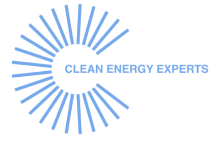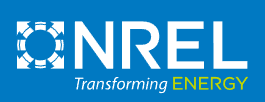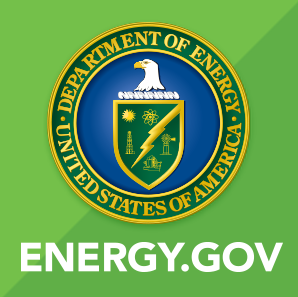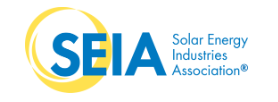Going Solar for Your Business 101: The Ultimate Guide

Solar energy is becoming increasingly popular for businesses seeking to reduce their environmental impact and save on energy costs. According to a report by the Solar Energy Industries Association (SEIA), solar power was the second-largest source of new electricity-generating capacity in the United States in 2022. As businesses seek to transition to more sustainable practices, solar energy is quickly becoming a practical business decision.
This comprehensive guide provides businesses with all the information they need to switch to solar energy. It begins with an overview of the benefits of solar energy for businesses:
- Reduced energy bills
- Potential tax incentives
- Improved public relations
- Reduction in your carbon footprint
We’ll also explain why businesses are transitioning to solar energy. This includes
- the shift toward more sustainable business practices
- the desire to reduce energy costs
- the positive impact it can have on the brand’s reputation
Finally, this guide offers practical tips for choosing a solar provider; navigating the installation process, the costs involved, and the different types of solar panel systems available; and maximizing your return on investment.
By the end of this guide, your business will be able to make informed decisions about going solar and start enjoying the benefits of clean, renewable energy.
Understanding Solar Energy
This guide will explain how solar energy works, discuss the different types of solar panel systems and compare their benefits and drawbacks.
How Solar Energy Works
Solar energy is acquired from the sun’s rays using solar panels. These panels, also known as photovoltaic (PV) panels, are made up of solar cells that convert sunlight into electricity. Solar panels absorb sunlight and release electrons, which are then harnessed to generate electrical power.
The process of generating solar energy begins with the panels absorbing sunlight, which excites the electrons in the solar cells. The excited electrons are then forced to flow in a specific direction, creating direct current (DC) electricity. This DC electricity is then sent to an inverter, which converts the DC electricity into alternating current (AC) electricity that can be used to power homes and businesses.
Different Types of Solar Panel Systems
There are two central solar panel system types: grid-tied and off-grid.
Grid-Tied Systems
Grid-tied solar panel systems are the most common type of solar energy system. These systems are connected to the electricity grid, allowing excess electricity generated by the solar panels to be sent back into the grid for use by others. Grid-tied systems are typically less expensive to install than off-grid systems and require less maintenance.
Benefits of Grid-Tied Systems:
- Lower installation costs
- Ability to sell excess energy back to the grid
- Reduced dependence on fossil fuels
- No need for battery maintenance
Drawbacks of Grid-Tied Systems:
- Dependence on the electricity grid
- No power during grid outages
Off-Grid Systems
As the name suggests, off-grid solar panel systems are not connected to the electricity grid. Instead, they use batteries to store excess energy generated by solar panels. This stored energy is used to power homes and businesses when no sunlight is available to generate electricity.
Off-grid systems are typically more expensive to install than grid-tied systems but offer greater independence from the electricity grid.
Benefits of Off-Grid Systems:
- Independence from the electricity grid
- Ability to generate and store energy for use during power outages
- Reduced dependence on fossil fuels
Drawbacks of Off-Grid Systems:
- Higher installation costs
- Need for battery maintenance
- Limited power generation during cloudy weather
Assessing Your Business’s Energy Needs
Before switching to solar, it is vital to assess your business’s energy needs and determine the type and size of the solar system that is right for you. In this guide, we will cover the key pointers for assessing your business’s energy needs.
Understanding Your Energy Consumption
The first step is to understand your energy consumption. This involves reviewing your energy bills and analyzing your energy usage patterns. By understanding your energy usage patterns, you can identify which areas of your business consume the most energy and where you can make the most significant energy savings.
Considerations for the Location of Your Solar Panels
The location of your solar panels is another aspect you should consider. The perfect location for a solar panel is a south-facing roof with minimal shading. Ground-mounted systems are also an option for businesses with ample outdoor space. However, this is only sometimes possible, and alternative locations may need to be considered.
Steps for Evaluating a Building’s Solar Potential
To determine the solar potential of your building, a solar energy consultant will typically carry out a site survey to assess factors such as the following:
- The angle and orientation of the roof
- The amount of shading
- The available space for solar panels.
They will then use this information to determine the optimal solar system for your business.
Determining the Size and Type of the Solar System You Need
Several factors must be considered when determining your business’s size and type of solar system. These include:
- The amount of available roof space
- The amount of energy you consume
- The local climate
- Your budget
A solar energy consultant can help you determine the appropriate size of the solar system based on your specific needs.
Tips for Working with a Solar Energy Consultant
Working with a solar energy consultant can help you select the most suitable solar system for your business. When selecting a consultant, look for someone with experience and expertise in the solar industry. It’s also a great idea to seek references from past clients and to check their credentials and certifications.
Cost of Going Solar
While solar energy has many benefits, such as being renewable and environmentally friendly, installing a solar system can be a concern for many. We will explore the factors that affect the cost of a solar system, government incentives, tax credits, the comparison of solar energy costs with traditional energy sources, financing options, and case studies of successful solar projects.
Factors That Affect the Cost of a Solar System
Several factors influence the cost of a solar system. Some of these factors include:
- The size of the system
- The type of panels used
- The location of the property
Additional costs may include labor, installation, and acquiring permits.
Understanding Government Incentives and Tax Credits
Many governments offer incentives and tax credits for solar installations to encourage the adoption of solar energy. In the USA, for instance, the federal government offers a solar investment tax credit (ITC) that allows homeowners and businesses to deduct up to30% of the cost of a solar system from their federal taxes. Additionally, some states offer incentives and tax credits to reduce the cost of solar installations further.
Cost of Solar Energy vs. Traditional Energy Sources
Although solar energy may have a higher initial cost than traditional energy sources, it can save homeowners and businesses money in the long run. Solar energy is renewable, so there are no fuel costs associated with using it, and the maintenance costs of a solar system are generally low.
Additionally, solar systems can often generate more energy than a household or business requires, resulting in excess energy being sold back to the utility company, generating additional revenue.
Overview of the Different Ways to Finance a Solar Energy System
There are several ways to finance a solar energy system. Some of the most popular options include purchasing the system outright, leasing the system, or financing the system.
1. Purchasing the System Outright
Purchasing a system outright can be a good option for homeowners or businesses with the capital to invest. While the initial cost may be high, the system will eventually pay for itself through energy savings and revenue from excess energy production.
Pros:
- Cost Savings: By purchasing the system outright, you save finances in the long run by avoiding monthly or annual fees associated with leasing or financing the system.
- Ownership: When you purchase the system outright, you have full ownership of the equipment, which means you can modify or upgrade it without any restrictions or penalties.
- No Credit Check: Since you do not need to finance the system, you don’t have to undergo a credit check, which can be a significant advantage if you have a challenged credit history.
- Tax Deductions: You can deduct the total cost of the equipment from your taxes, which can result in significant savings.
Cons:
- High Upfront Cost: The most significant disadvantage of purchasing a system outright is the high upfront cost, which can be a substantial burden on your budget, especially if you’re a small business owner or an individual with limited financial resources.
- Maintenance and Repairs: As the system owner, you are responsible for all maintenance and repair costs, which can be expensive and time-consuming, especially if you do not have the necessary technical skills.
- Obsolescence: Technology is constantly evolving, and the equipment you purchase today may become outdated in a few years, so you may need to replace it sooner than anticipated.
- Limited Flexibility: Once you purchase the system, you are committed to it. You have limited flexibility to switch to a different system or technology if your needs change or a better option becomes available.
Leasing the System
Leasing a system can be a good option for those who need more capital to purchase a system outright. Customers interested in solar systems can also look into power purchase agreements (PPAs), which allow homeowners or businesses to purchase the energy generated by a solar system without having to purchase the system itself.
However, lease agreements often come with a long-term contract, and the homeowner or business typically does not own the system.
Pros:
- Lower Upfront Costs: Leasing a solar system requires little to no money up front, making it a more affordable option for many people who want to switch to solar energy but cannot purchase it outright.
- Reduced Monthly Costs: When you lease a solar system, you typically pay a fixed monthly fee for the duration of the lease. This fee is often lower than what you would pay for traditional utility power, which means you can save funds on your electricity costs.
- No Ownership Responsibility: Leasing a solar system typically includes maintenance and repair services, saving you time and money in the long run.
- Hedge Against Inflation: As energy costs rise your set lease payments save you more and more.
- No Risk: If the solar system doesn’t generate the expected amount of electricity, the company that owns the system is responsible for any loss, so there are no worries about any financial risk.
Cons:
- Long-Term Cost: Although leasing a solar system can save you money on your monthly electricity bills, the overall cost of the lease over the entire agreement term can be more expensive than purchasing the system outright.
- Limited Control: Since you don’t own the solar system, you have limited control over it. You’re restricted from making any modifications or upgrades and may need access to the latest technology.
- No Ownership Equity: Since you don’t own the system, you don’t have any equity in it, which means you can’t use it as collateral or sell it to generate income. This can be a disadvantage if you want to generate income from your solar system
- Contractual Obligations: When you lease a solar system, you typically sign a long-term contract, which can be difficult to break or modify. This can limit your flexibility if your energy needs or financial situation changes.
- Limited Tax Benefits: Since you don’t own the solar system, you may not be eligible for certain tax benefits or incentives available to homeowners who purchase a solar system outright.
Case Studies of Successful Solar Projects
Many homeowners and businesses have successfully implemented solar systems and have seen significant savings as a result.
- IKEA, California: IKEA has installed solar panels in many of its stores and warehouses in California. The company aims to produce as much renewable energy as it consumes by 2020. The solar panels on IKEA’s stores in California have a combined capacity of 10.6 MW, making them one of the largest corporate solar installations in the state.
- North Adams, Massachusetts: This small town is powered by their 3.5-megawatt solar array installed in 2015. Installed at no upfront cost to taxpayers, their solar system has saved them about $378,000 of their $900,000 electric bill.
- King Orchards Fruit Co. LLC, Michigan: The owners had installed a fixed 52 kW ground-mounted solar system in 2015, which powers their bakery and retail store. They bank the excess energy back into the grid for use on days when the system isn’t able to generate enough power to meet the farm’s needs and are credited at $0.06/kWh.
Choosing a Solar Provider
Choosing the right solar provider can take time and effort, given the numerous companies offering these services. Here are some critical factors to consider when selecting a solar provider.
Questions to Ask When Selecting a Solar Provider
Below are some important questions you may need to ask potential solar providers:
- What type of solar panels do you install, and how efficient are they?
- What are the costs associated with the installation of solar panels?
- What financing options do you offer, and what are the interest rates?
- What is the warranty period for the solar panels and the installation?
- How long will the installation process take, and what is involved?
- Do you offer maintenance and repair services, and at what cost?
Key Factors to Consider When Evaluating Solar Providers
Some of the crucial considerations include:
1. Reputation and Experience
One of the essential factors to consider when selecting a solar provider is their reputation and experience. Look for providers with a proven track record of excellence in the industry. Check how long the company has been in business and its customer satisfaction ratings. This information can be found on their website or through online reviews.
2. Professionalism and Expertise
Choose a provider with knowledgeable and experienced professionals who can guide you through selecting the right solar panels and installation options. A professional provider will assess your needs and offer customized solutions that meet your energy goals and budget. These providers should also know how to answer any queries customers interested in solar systems may have.
3. Quality of Products and Services
Select a provider that offers quality solar panels that are energy-efficient and durable. Check that they use top-rated brands and that their installations meet industry standards. It’s also important to consider the provider’s warranty policies as well as their post-installation services and maintenance.
Importance of Customer Reviews and References
When evaluating a solar provider, checking customer reviews and references are essential. Reviewing previous clients can give you an idea of the provider’s professionalism, expertise, and overall service quality. It’s also helpful to ask the provider for references and speak to previous customers about their experience working with the provider.
If you’re finding it difficult to look for reputable solar providers in your area, consider connecting with a solar lead generation provider. This will help you save time and effort and ensure you’re getting competitive pricing and high-quality service and equipment.
Installation and Maintenance
Installing and maintaining a solar energy system can be daunting, especially for those new to the technology. Below is a step-by-step guide to installing a solar energy system. The guide will discuss the importance of a comprehensive site assessment, explain the permits and approvals required for installation, offer tips for selecting a reputable installer, and outline the solar maintenance requirements and best practices for keeping your system running smoothly.
A Step-by-Step Guide to Installing a Solar Energy System
The following are the steps involved in the installation of a solar energy system:
- Site assessment: Before you start the installation process, assess your site’s suitability for solar energy production. Factors such as your roof or land size, orientation, shading, and climate will determine the best solar system size and design.
- Design: After assessing your site, the next step is to design your solar system. A reputable installer will work with you to determine the optimal system size, the number of panels needed, and the type of solar inverter to be used.
- Permits and approvals: Before installing a solar energy system, you must obtain the necessary permits and approvals from your local authorities. This step can vary depending on your location, so working with a reputable installer knowledgeable about local requirements is essential.
- Installation: Once all the necessary permits and approvals are in place, the installation process can begin. This involves mounting the solar panels, installing the inverter, and connecting the system to your building or home’s electrical system.
- Inspection: After the installation, the system must be inspected to ensure it meets local and national safety standards. This step ensures that the system is operating safely and efficiently.
- Monitoring: After installation, you can monitor your solar energy system’s performance to ensure it produces the expected energy. Many systems come with monitoring tools that allow you to track your system’s output in real time.
Importance of a Comprehensive Site Assessment
A comprehensive site assessment is critical to determine the suitability of your location for solar energy production. A site assessment will consider several factors, including the size and orientation of your roof, shading, climate conditions, and electrical usage. With this information, you can design the optimal solar energy system for your site, ensuring that it produces the most energy and is cost-effective.
Understanding the Permits and Approvals Required for Installation
Obtaining the necessary permits and approvals for solar installation can be complicated. Working with a reputable installer who can guide you through the process will save you the time and energy of looking up and inquiring about these permits. The type of permits required can vary depending on your location and the size of the solar energy system you want to install. You will need to obtain permits for electrical work, structural engineering, and zoning.
Tips for Selecting a Reputable Installer
When selecting an installer for your solar energy system, it’s important to choose a reputable company with experience in solar installations. Some tips for selecting an installer include:
- Check their credentials: Look for a licensed and insured installer with a good reputation in the industry.
- Ask for references: Ask the installer for references from previous customers and follow up with these references to ensure they are satisfied with the installation.
- Compare quotes: Get quotes from multiple installers to compare prices and ensure you are getting a fair price.
- Look for warranties: A reputable installer should offer warranties for their work and the solar panels and equipment they install.
Maintenance Requirements and Best Practices
Here are some maintenance requirements and best practices for solar systems:
- Keep the panels clean: The most critical maintenance task for solar panels is to keep them clean. Dust, debris, and dirt can accumulate on the panels, reducing efficiency. Cleaning the panels regularly, especially after a dust storm, improves their performance. Use a mild detergent and a soft-bristled brush to clean the panels, or hire a professional cleaning service.
- Check for damage: Inspect the panels regularly for damage, such as cracks or other signs of wear and tear. Any damage to the panels can reduce their efficiency and require repairs or replacements.
- Monitor performance: Monitoring your solar system’s performance can help identify potential issues. A significant drop in output could indicate a problem with the panels or other components. Please keep track of the amount of energy generated by the system and compare it to previous months or years.
- Check wiring and connections: Ensure that all wiring and connections are in good condition and free from damage. Any frayed wires or loose connections can cause problems with the system.
- Trim nearby trees: If you have trees or other foliage near your solar panels, make sure to keep them trimmed. Overgrown trees or branches can shade the panels and reduce their efficiency.
- Schedule regular professional maintenance: While you can perform some maintenance tasks yourself, it’s a good idea to schedule regular professional maintenance to ensure your system is in optimal condition. A professional can check for any issues, replace worn-out components, and perform necessary repairs.
Monitoring of Your Solar System
As solar energy becomes more popular, it’s essential to ascertain that your solar system is working optimally to maximize its benefits. One way to ensure the best performance is through regular monitoring.
Benefits of Monitoring Your Solar System’s Performance
- Identify and prevent issues: Monitoring your system’s performance allows you to detect and address potential issues before they become significant problems that may affect system performance.
- Optimize performance: Monitoring enables you to identify inefficiencies in your system and take corrective measures to improve performance.
- Energy savings: Monitoring helps you track energy usage and identify areas where energy savings can be made.
- Increased ROI: Regular monitoring and maintenance can help increase the life of your system and improve its ROI.
Choosing a Monitoring System and Service Provider
When choosing a monitoring system and service provider, consider the following:
- Compatibility: Ensure that the monitoring system is compatible with your solar system.
- Cost: Consider the cost of the monitoring system and the ongoing service fees.
- Features: Look for features that suit your needs, such as real-time monitoring, alerts, and analytics.
- Reputation: Choose a reputable service provider with a history of providing reliable and effective service.
Common Mistakes Made Before Going Solar
Below are some common mistakes business owners make before going solar that can cause problems and headaches down the line. This guide will look at common mistakes and how to prevent them.
1. Not Doing Enough Research
One of the biggest blunders business owners make before going solar is not doing enough research. Going solar requires both time and money, and it’s essential to make sure you’re making the right decision for your business. Some business owners may be swayed by aggressive sales tactics or the promise of quick returns, but it’s crucial to research and make an informed decision.
Prevention
Before making any decisions:
- Do extensive research.
- Talk to other business owners who have gone solar, read up on solar power’s benefits and drawbacks, and get quotes from different solar providers.
- Be bold and ask questions.
2. Underestimating Your Energy Needs
Another common mistake business owners make before going solar is underestimating their energy needs. Solar panels can only generate a certain amount of energy, and if you need more panels to meet your needs, you may have to rely on traditional energy sources or face power outages.
Prevention
- Ensure you know your energy needs.
- Look at your past energy bills to get an idea of how much energy you use on average, and factor in any future growth or expansion plans.
- Work with your solar provider to design a system for energy needs.
3. Choosing the Wrong Solar Provider
Choosing the wrong solar provider can also be a costly mistake. Some providers may overpromise and underdeliver or use defective materials that can lead to problems down the line. Choosing a provider with a good reputation and a track record of success is essential.
Prevention
When choosing a solar provider, do your research. Look for testimonials and reviews from past customers, and ensure that the provider has experience working with businesses like yours. Ask for references or examples of their past work.
4. Not Planning for Maintenance and Repairs
Solar panels require regular maintenance and may need repairs from time to time. Some business owners need to plan for these costs, which can add up over time.
Prevention
When budgeting for your solar project, make sure to factor in the cost of maintenance and repairs. Work with your solar provider to develop a maintenance plan and schedule regular checkups to keep your system running smoothly.
5. Forgetting About Incentives and Tax Credits
Finally, some business owners need to remember the incentives and tax credits available for going solar. These can significantly reduce the cost of your solar project and help you recoup your investment more quickly.
Prevention
Before going solar, make sure to research the incentives and tax credits that are available in your area. Work with your solar provider to ensure you’re taking advantage of all the available benefits.
How to Track and Measure Energy Savings
Here is how to track and measure your solar energy savings:
- Monitor your energy usage: Before installing solar panels, it’s crucial to track your energy usage over some time to determine how much electricity you consume on a daily, weekly, and monthly basis. This will give you a baseline to compare your energy usage after installing solar panels.
- Determine your solar panel’s capacity: Once you know how much energy you consume, you can calculate the capacity of your solar panels. This will tell you how much electricity your solar panels can generate and help you determine how much you can expect to save.
- Track your energy production: Most solar panel systems have a real-time monitoring system that tracks your energy production. You’ll be able to see how much electricity your solar panels generate and how much electricity you use.
- Compare your energy production and usage: You can determine how much electricity you save by comparing your energy production and usage. Suppose you are generating more electricity than you are consuming; you can trade in the excess energy back to your utility company for a credit on your bill.
- Calculate your savings: To calculate your solar energy savings, you will need to consider the cost of your solar panels, installation, and maintenance as well as any incentives or rebates you may have received. To determine your savings, you can compare your current electricity bill to what it would have been without solar panels.
Financial Benefits of Going Solar
Going solar can provide significant financial benefits, including:
- Lower electricity bills: You can minimize or even eliminate your electricity bill by generating your own electricity.
- Increased home value: Solar panels can increase your house’s value, making it more appealing to potential buyers.
- Tax incentives and rebates: Many states offer rebates and tax incentives for installing solar panels, which can significantly reduce the cost of installation.
- Net metering: Net metering lets you sell excess electricity back to your utility company, providing you with credit on your bill.
Environmental Benefits of Going Solar
In addition to the financial benefits, going solar can positively impact the environment. By utilizing solar energy instead of fossil fuels, you can:
- Reduce greenhouse gas emissions: Solar energy produces no greenhouse gas emissions that contribute negatively to climate change.
- Conserve natural resources: Solar energy uses no water and does not require using natural resources such as coal or natural gas.
- Decrease dependence on foreign oil: By generating your electricity, you can reduce your dependence on foreign oil.
- Encourage renewable energy: By using solar energy, you support the growth of renewable energy and reduce our reliance on fossil fuels.
Conclusion
Going solar for your business is a smart move that can provide numerous benefits for your company. The transition to solar energy is an innovative and beneficial move for businesses. By going solar, you can save money, reduce your carbon footprint, and support a sustainable future. We encourage business owners to start the transition by assessing their energy usage, exploring financing options, and working with reputable solar panel installers.
References
- Decisions, Decisions: Choosing the Right Solar Installer. (n.d.). Energy.Gov. https://www.energy.gov/eere/solar/articles/decisions-decisions-choosing-right-solar-installer
- Grid-Connected Renewable Energy Systems. (n.d.). Energy.Gov. https://www.energy.gov/energysaver/grid-connected-renewable-energy-systems
- Money Matters: How to Finance Your Rooftop Solar Energy System. (n.d.). Energy.gov. https://www.energy.gov/eere/solar/articles/money-matters-how-finance-your-rooftop-solar-energy-system
- Off-Grid or Stand-Alone Renewable Energy Systems. (n.d.). Energy.gov. https://www.energy.gov/energysaver/grid-or-stand-alone-renewable-energy-systems
- Solar Installed System Cost Analysis. (n.d.). Solar Market Research and Analysis | NREL. https://www.nrel.gov/solar/market-research-analysis/solar-installed-system-cost.html
- Solar Market Insight Report 2022 Q4 | SEIA. (n.d.). SEIA. https://www.seia.org/research-resources/solar-market-insight-report-2022-q4
- Traditional energy sources Definition | Law Insider. (n.d.). Law Insider. https://www.lawinsider.com/dictionary/traditional-energy-sources
- United Nations. (n.d.). What is renewable energy? | United Nations. United Nations. https://www.un.org/en/climatechange/what-is-renewable-energy#:~:text=Renewable%20energy%20is%20energy%20derived,plentiful%20and%20all%20around%20us.





